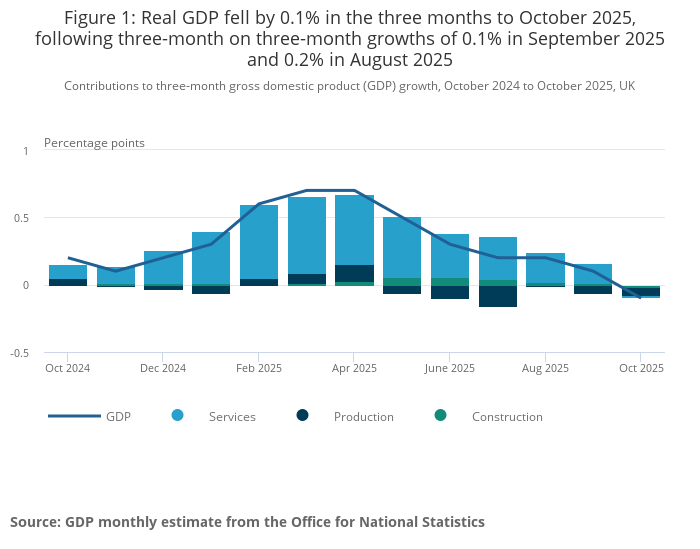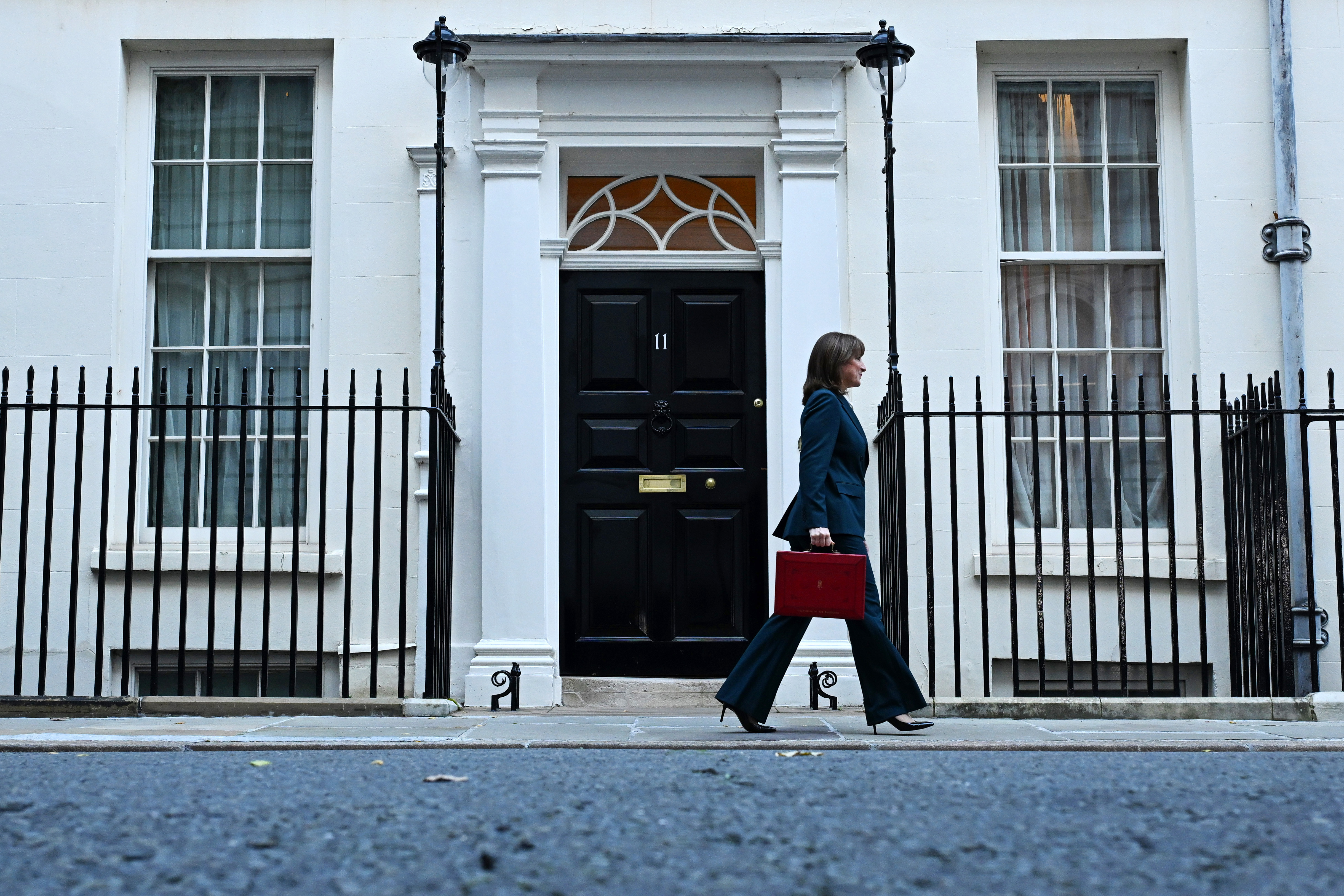ONS: UK economy unexpectedly shrinks by 0.1% in October – what does it mean for interest rates?
The latest GDP figures strengthen the case for a base rate cut in December, experts suggest


The UK economy unexpectedly shrank in the three months to October, increasing the likelihood interest rates are cut later this month.
Gross Domestic Product (GDP) fell by 0.1%, according to the latest figures from the Office for National Statistics (ONS), following growth of 0.1% in the three months to September and 0.2% in the three months to August. Economists had predicted a 0.1% rise in October.
Growth in the services sector flatlined while the production and construction industries saw a fall of 0.5% and 0.3%, respectively.
MoneyWeek
Subscribe to MoneyWeek today and get your first six magazine issues absolutely FREE

Sign up to Money Morning
Don't miss the latest investment and personal finances news, market analysis, plus money-saving tips with our free twice-daily newsletter
Don't miss the latest investment and personal finances news, market analysis, plus money-saving tips with our free twice-daily newsletter
The fall in the production sector was mainly triggered by less vehicle manufacturing. Jaguar Land Rover was hit by a major cyber attack at the end of August which stalled production lines for weeks.
Scott Gardner, investment strategist at investment banking company J.P. Morgan, said pre-Budget jitters also contributed to October’s downbeat GDP figures.
“Speculation about potential Budget announcements had a numbing effect on consumers and businesses in the lead up to the chancellor’s speech at the end of November,” Gardner said.
The latest GDP figures will come as a blow to chancellor Rachel Reeves as she looks to get the UK economy back on track.
The Labour government has made growth one of its main priorities, but quarterly ONS figures suggest GDP has slowed since the start of 2025.
Rob Wood, chief UK economist at Pantheon Macroeconomics, suggested October’s poor GDP figures could see this trend continue.
“Weaker-than-expected GDP growth drags our call for Quarter Four GDP growth down to 0.1% quarter-to-quarter, below the Monetary Policy Committee’s (MPC) forecast of 0.3%,” Wood said.
An HM Treasury spokesperson said: “We are determined to defy the forecasts on growth and create good jobs, so everyone is better off, while also helping us invest in better public services.
“That is why the chancellor is taking £150 off energy bills, protecting record investment in our infrastructure, and we are backing major planning reforms, the expansion of Heathrow and Gatwick airports, and the construction of Sizewell C.”

Credit: ONS
Low growth increases chances of a base rate cut
The Bank of England’s MPC will be watching today’s GDP figures closely as it weighs up what to do when it reviews the base rate on 18 December.
The Consumer Price Index (CPI) measure of inflation is still above the bank’s 2% target at 3.6%. However, the MPC said in November it believes inflation has peaked, partly due to an easing in rising wages.
Clare Lombardelli told the Commons’ Treasury Committee this week measures announced in the Budget, including cutting energy prices and freezing rail fares, could also knock half a percentage point off inflation from April 2026.
Interest rates are already being heavily tipped to come down from 4% to 3.75% next week. In a research note published this week, HSBC said it expects the BoE to cut the base rate by 25 basis points to 3.75%.
This, HSBC said, is in line with market expectations, which is pricing in a 93% chance of a cut.
Wood, from Pantheon Macroeconomics, said the surprise October GDP figures would strengthen the case for a cut.
“Weak GDP adds to the reasons for the MPC to cut interest rates next week. Rate setters would need a huge surprise in inflation and the labour market data published next week to stop a cut,” Wood said.
November’s CPI inflation data is out on 17 December while labour market data is published on 16 December.
Get the latest financial news, insights and expert analysis from our award-winning MoneyWeek team, to help you understand what really matters when it comes to your finances.

Sam has a background in personal finance writing, having spent more than three years working on the money desk at The Sun.
He has a particular interest and experience covering the housing market, savings and policy.
Sam believes in making personal finance subjects accessible to all, so people can make better decisions with their money.
He studied Hispanic Studies at the University of Nottingham, graduating in 2015.
Outside of work, Sam enjoys reading, cooking, travelling and taking part in the occasional park run!
-
 Metals and AI power emerging markets
Metals and AI power emerging marketsThis year’s big emerging market winners have tended to offer exposure to one of 2025’s two winning trends – AI-focused tech and the global metals rally
-
 8 of the best houses for sale with beautiful fireplaces
8 of the best houses for sale with beautiful fireplacesThe best houses for sale with beautiful fireplaces – from a 15th-century cottage in Kent to a 17th-century palazzo in Oxfordshire
-
 UK interest rates: Bank of England lowers rates to 3.75%
UK interest rates: Bank of England lowers rates to 3.75%The Bank of England’s Monetary Policy Committee (MPC) has cut interest rates from 4% to 3.75%
-
 Rachel Reeves's punishing rise in business rates will crush the British economy
Rachel Reeves's punishing rise in business rates will crush the British economyOpinion By piling more and more stealth taxes onto businesses, the government is repeating exactly the same mistake of its first Budget, says Matthew Lynn
-
 The consequences of the Autumn Budget – and what it means for the UK economy
The consequences of the Autumn Budget – and what it means for the UK economyOpinion A directionless and floundering government has ducked the hard choices at the Autumn Budget, says Simon Wilson
-
 Why UK stocks are set to boom
Why UK stocks are set to boomOpinion Despite Labour, there is scope for UK stocks to make more gains in the years ahead, says Max King
-
 Electric vehicle drivers to be charged new per mile tax from 2028
Electric vehicle drivers to be charged new per mile tax from 2028Electric vehicle drivers will be forced to pay a 3p per mile tax, as taxation will be brought closer in line with petrol and diesel cars
-
 Autumn Budget winners and losers
Autumn Budget winners and losers"Someone has to suck up the costs - those who can pay will pay,” says Kalpana Fitzpatrick
-
 Salary sacrifice cap of £2,000 to be introduced in 2029
Salary sacrifice cap of £2,000 to be introduced in 2029The government says 74% of basic rate taxpayers currently using salary sacrifice will be unaffected by the change
-
 Autumn Budget live: Rachel Reeves cuts cash ISA limit, introduces mansion tax and more
Autumn Budget live: Rachel Reeves cuts cash ISA limit, introduces mansion tax and moreLive updates Chancellor Rachel Reeves unveiled a slew of tax hikes and ISA reforms in her second Autumn Budget. We take a look at the latest updates and analysis